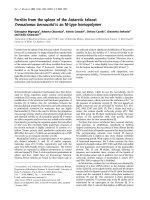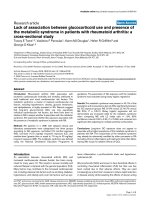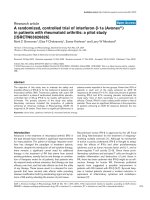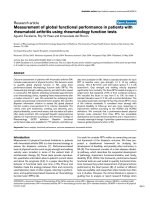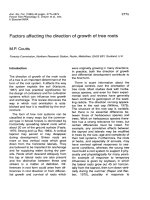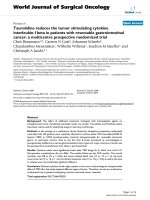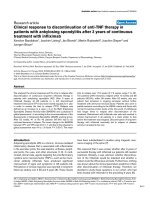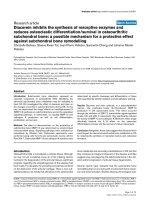Báo cáo y học: " Factors predicting the outcome of customised foot orthoses in patients with rheumatoid arthritis: a prospective cohort stud" pps
Bạn đang xem bản rút gọn của tài liệu. Xem và tải ngay bản đầy đủ của tài liệu tại đây (256.78 KB, 8 trang )
RESEARCH Open Access
Factors predicting the outcome of customised
foot orthoses in patients with rheumatoid
arthritis: a prospective cohort study
Marike van der Leeden
1,2*
, Karin Fiedler
1
, Annelies Jonkman
1
, Rutger Dahmen
1
, Leo D Roorda
1
,
Dirkjan van Schaardenburg
3,4
, Joost Dekker
1,2
Abstract
Background: Conservative management of foot problems in patients with rheumatoid arthritis (RA) may consist of
the prescription of customised foot orthoses. Indications for foot orthoses are not clear and the effectiveness of the
intervention is highly variable among patients. Knowledge on which patients benefit the most from foot orthoses
can help to select patients eligible for this type of intervention. The objective of the present study was to
determine clinical and demographic factors that predict the outcome of customised foot orthoses on pain and
disability in patients with RA.
Methods: A total of 135 RA patients who were supplied with customised foot orthoses were included in this
prospective cohort study. Pain and disability were measured before and after the intervention period using a
Numeric Rating Scale (NRS) for foot pain, the Foot Function Index (FFI), the Western Ontario and McMasters
Universities Osteoarthritis Index (WOMAC) and a 10-meter walking test. The intervention period consisted of one or
more appointments with the podiatrist during which the foot orthoses were customised.
Swollen foot joint count, foot deformity scores, forefoot peak pressure, disease duration, age, gender, body mass
index and baseline values of the outcome measures were selected as potential factors predicting outcome.
Multivariate linear regression analyses were performed to determine factors associated with change in pa in and
disability (at P < 0.05).
Results: Disease duration was negatively associated with the change scores in NRS foot pain (P = 0.018), WOMAC
pain (P = 0.001), FFI disability (P = 0.003) and WOMAC physical function (P = 0.002). Age was negatively associated
with the change score in 10 meter walking time (P = 0.008). For all outcome measures baseline values were
positively associated with the change scores (P < 0.001).
Conclusions: Shorter disease duration predicted greater improvements in self-reported foot pain and disability,
and younger age predicted greater improvements in walking time after intervention with foot orthoses. Also,
higher baseline values of pain and disability predicted greater improvements. Referral for conservative
management with foot orthoses in the early stage of RA seems important when aiming to achieve reduction in
pain and improvement in daily activities.
* Correspondence:
1
Reade, Centre for Rehabilitation and Rheumatology (formerly Jan van
Breemen Institute), Dept. of Rehabilitation Research, Amsterdam, Netherlands
Full list of author information is available at the end of the article
van der Leeden et al. Journal of Foot and Ankle Research 2011, 4:8
/>JOURNAL OF FOOT
AND ANKLE RESEARCH
© 2011 van der Leeden et al; licensee BioMed Central Ltd. This is an Open Access article distributed under the te rms of the Creative
Commons Attribution Li cense ( which permits unrestricted u se, distribution, and
reproduction in any medium, provided the original work is proper ly cited.
Background
Throughout the course of rheumatoid arthritis (RA) foot
problems appear to be highly prevalent [1-5], most often
causing pain during weight bearing activities such as
standing, walking and running [4,6]. The primary man-
agement o f RA-related foot problems is pharmacologi-
cal, although conservative and/or surgical intervention
may be indicated [7]. Conservative intervention may
consist of foot orthoses in over-the-counter shoes or
therape utic footwear. Surgical inter vention may be con-
sidered when conservative intervention is not satisfac-
tory in reducing foot pain and consequent disability or
when to attempt to obtain a better long term prognosis.
The effectiveness of foot o rthoses has been shown in
several randomized controlled trials [8-10]. However,
indications for foot orthoses are no t clear and the effec-
tiveness of the intervention is highly variable among
patients [11]. Knowledge on which patients benefit the
most from foot orthoses can help to select patients eligi-
ble for this type of intervention. Studies investigating
factors predicting the outcome of foot orthoses on pain
and disability in RA are lacking to date. Several clinical
and demographic factors may potentially predict the
outcome. Hypotheses can be generated based on the lit-
erature and clinical experience.
Potential clinica l predictors related to the foot include
thepresenceandseverityofdiseaseactivityinthefoot
joints, the pres ence and severity of structural foot defor-
mities and the magnitude of pressure under the forefoot.
Higher disease activity in the foot joints is expected to
predict poorer outcome since d isease activity and the
associated pain are influenced by pharmacological treat-
ment [7], rather than by foot orthoses. More severe
structural foot deformities are also expected to predict
poorer outcome since foot orthoses may be insufficient
to accommodate to severe deformities. Moreover, the
foot with sev ere deformities may not fit into over-the
counter s hoes [12]. High pressure under the forefoot is
hypothesized to be associated with a better outcome,
since foot orthoses in RA have been shown to reduce
high forefoot pressure and consequently reduce pain
and disability [13,14]. Another potential clinical predic-
tor is disease duration. Shorter disease duration is
expected to be associated with a better outcome since
the consequences of the disease may be more amenable
to intervention in an early disease stage than in a later
disease stage when irreversible joint damage and defor-
mities could have been developed [15-17].
Demographic factors, i.e. a ge and gender, and body
mass index are also potential predictors of the outcome
of foot orthoses. Older patients are expected to report
poorer outcome since these patients experience addi-
tional age-related disabilities [18] which might be less
responsive to an intervention with foot orthoses than
RA-specific disabi lities. Gender might also be a predic-
tor of outcome. Some recent studies suggest that men
with RA have better responses to pharmacological inter-
ventions than women with RA [19]. Ba sed on these
findings gender could potentially be a predictor
although no evidence for g ender differences in the out-
come of conservative interventions in RA has been
found. Body mass index (BMI) might b e a predictor of
outcome since overweight is related to co-morbidities,
such as cardiovascular diseases [20], causing disabilities
which are less likely to respond to an intervention with
foot orthoses. Finally, baseline values of pain and dis-
ability are expected to be predictors of outcome on
these measures. Patients with high baseline scores have
more opportunity to improve than patients with already
low baseline scores.
The purpose of the present study was to determine
clinical and de mographic factors that predict the out-
come of customised foot orthoses on pain and disability
in patients with RA.
Methods
Design
Patients of an outpatient centre for rehabilitati on and
rheumatology (Reade, formerly Jan van Breemen Instituut)
in the Netherlands served as the study population for this
prospective cohort study. Since 2006 patients with a refer-
ral to podiatry for arthritis- re lated foot complaint s were
assessed using standardized measurements. Patients have
been measured at baseline (before the start of the inter-
vention) and at final follow up ( directly after the end of
the intervention period). The intervention period consisted
of one or more appointments with the podiatrist during
which the foot problem was diagnosed and managed. Indi-
vidual diagnosis and evaluation was the primary purpose
of the measurements. In addition, data have been stored
anonymously fo r evaluation of foot care on a group level.
According to Dutch law, using data from routine health
care for scientific purposes is permitted: no separate
approval of the Human ethics board is required.
Patients
For the present study the following criteria for inclusion
were used: 1) RA diagnosed by a rheumatologist (accord-
ing to the American Rheumatism Association 1987 revised
criteria [21]), 2) referral to a podiatrist for RA-related foot
complaints, 3) uni- or bilateral foot complaints, 4) interven-
tion with customised foot orthoses and 4) older than 18
years of age. Exclusion criteria were: 1) any other medical
condition that could explain the foot complaints, 2) inabil-
ity to walk unassisted with or without walking aids and
3) inability to complete questionnaires (because of
van der Leeden et al. Journal of Foot and Ankle Research 2011, 4:8
/>Page 2 of 8
language or cognitive problems). The inclusion period was
April 2006 to September 2009.
Intervention
The foot orthoses were custom designed and manufac-
tured by experienced podiatrists who were accustom to
treating RA-related foot p roblems. There were three
podiatrists involved. Most of the foot orthoses were con-
structed by using prefabricated orthoses. The half supple-
ments were model U and made from ethylene vinyl
acetate (EVA) shore 70 o r Microcork shore 80 ( Fisher
Group bv, Meppel, the Netherlands). The full supplements
were model Ergonomica and were made from EVA shore
60 (Fisher Group bv, Meppel, the Netherlands). The pre-
fabricated orthoses were heated and moulded to the
patient’s foot while using the neutral suspension technique
with handmade functional corrections [22]. Some orthoses
were handmade using the Lavigne technique [22]). Various
cover materials were used (leather, cloth material, spenco
or no cover). For the majority of orthoses a cushioning
material such as PPT or plastazoate was added at the
forefoot before the cover was applied.
In addition to the prescription of foot orthoses, all
patients were given advice regarding shoes. The general
anatomy and cha racteristics of a shoe were explained
and t ailored advice was given which took into account
the patient’ s individual needs. Characteristics such as
shoe weight, shoe fitting including shoe depth and
model (sandals, shoe or ankle high boots), heel height,
sole stiffness and cushioning properties, malleability of
the s hoe upper and the fastening apparatus (l aces, Vel-
cro, buckle o r zipper) were all considered. After giving
theshoeadvicepatientswereprovidedwithalistof
shoe shops selling appropriate s hoes for patients with
RA-related foot problems.
In some cases toe orthoses to address toe deformities
were made. For example overlying toes wer e held in a
better alignment with a silicone orthosis. Small shoe
adaptations were performed when necessary, for exam-
ple stretching or softening the leather upper at pressure
points and different lacing techniques. In some cases,
patients were referred to orthopaedic shoemakers for
rocker bottoms or heel height corrections.
After receiving the foot orthoses patients returned for a
review appointment with the podiatrist. During this
appointment the foot orthoses were re-evaluated and could
be altered when the effect was not satisfactory in reducing
pain according to the patient. If necessary, follow up visits
were arranged to further optimize the foot orthoses.
Outcome measures
Pain and disability were measured at baseline (T0) and at
final follow up (T1) using questionnaires and a walking
test.
A Numeric Rating Scale (NRS) was used to assess fo ot
pain during walking. Patients were asked to score the
average amount of foot pain they h ad experienced dur-
ing walking in the previous week using a NRS, where
0 indicates no pain and 10 indicates severe pain.
The Foot Function Index (FFI) was used to measure
the impact of foot problems [23,24]. The scale consists
of 23 items divided into 3 subscales: pain (9 items), dis-
ability (9 it ems) and act ivity restriction (5 items). For
thepresentstudyamodifiedversionoftheFFIwas
used. The modified FFI uses a 5 point-scale for item
response [24], where the o riginal FFI uses a 100 mm
VAS [23]. To calculate the subscale scores and the total
score the item scores were summed, divided by the
maximum possible sum of the item scores and then
multiplied by 100. The scores range from 0 to 100; the
higher the score the more pain, disability and activity
restriction respectively. For the present study the
subscales pain and disability were used as outcome
measures.
The Western Ontario and McMasters Universities
Osteoarthritis Index (WOMAC) was used to measure
the impact of arthritis in the lower extremities. The
WOMAC originally measures pain, joint stiffness and
physical function as the impact of osteoarthritis in hips
and knees [25,26]. However, the WOMAC has also been
reported to be an appropriate measure of lower extre-
mity related pain, joint stiffness and physical function in
RA [27]. The WOMAC consists of 24 items divided into
3 subscales: pain (5 items), joint stiffness (2 items) and
physical function (17 items). To calculate the subscale
scores and the total score the item scores were summed,
divided by the maximum possible sum of the item
scoresandthenmultipliedby100.Thescoresrange
from 0 to 100; the higher the score, the more pain, stiff-
ness and disability respectively. For the present study
the subscales pain and physical function were used as
outcome measures.
A 10-meter walking time test was used as a perfor-
mance-based measure of phys ical function. T he patien ts
were instructed to walk 10 meters on a self-selected,
comfortable walking pace while wearing their own shoes
and -after the intervention- wearing the provided foot
orthoses in their shoes. A walking aid was permitted
during testing if patients used one for daily mobility.
The time to walk 10 meters was recorde d (in seconds).
A comparable walking time test, that is the 50-foot
walking time test, was found to be reliable, valid and
responsive in patients with RA [28-30].
Potential predictors
Potential facto rs predi cting changes in pain and di sabil-
ity after the intervention with foot orthoses were mea-
sured at baseline (T0).
van der Leeden et al. Journal of Foot and Ankle Research 2011, 4:8
/>Page 3 of 8
Gender, age (in years), body mass index (in kg/m
2
)
and disease duration as time since medical diagnosis (in
years) were recorded for each patient.
A swollen foot joint count was used to record disease
activity in the foot join ts. Only soft tissue swelling was
accounted for [31]. Scoring was based on the absence
(= 0) or presence (= 1) of joint swelling according to the
podiatrist after palpation along the joint margins. Swel-
ling of the interphalangeal joints, metatarsophalangeal
(MTP) joints 1 to 5, tarsal complex, subtalar joint and
talocrural joint was evaluated in both feet. Since no foot
joint count has been studied for its validity or reliability,
a foot joint count that was routinely used by the podia-
trists of our centre was used as the most appropriate
alternative. The number of swollen joints in both feet
was summed (range 0-18).
The Structural Index score [32] was used to quantify
forefoot and rearfoot deformities. Hallux valgus (absent =
0, present = 1), MTP subluxation (number 0-5), 5th
MTP exostosis (absent = 0, present = 1), and claw/ham-
mer toe deformities (number 0-5) were considered for
the forefoot deformity score (range 0-12). Calcaneus val-
gus/varus angle (0-5° = 0; 6-10° = 1; 11-15° = 2;
>15° = 3), ankle range of motion (46 -60° = 0; 31-45° =
1; 15-30° = 2; <15° = 3) and pes planus/cavus deformitiy
(absent = 0, present = 1) were considered for the rear-
foot deformity score (range 0-7). The mean forefoot and
rearfoot deformities scores of the right and left foot
were used in the analyses.
Plantar pressure measurements were performed to
determine peak pressure under the forefoot using an
EMED
®
-nt (Novel Electronics, Novel gmbh, Munich,
Germany) platform (4 sensors per cm
2
,samplefre-
quency 50 Hz). The platfo rm was mounted in the mid-
dle of a walkway of 5 meters. A two-step method of
collecting plantar pressure measurements was used [33].
Data from both feet were collected and three correct
measurements per foot were recorded. A measurement
was rejected wh en the whole foot failed to be placed on
the platform or when the patient was off balance
according to the tester or to the patient. All patients
started walking with their right foot. Pressure data were
analysed with Novel-Ortho
®
and Novel-Win
®
software.
A division mask (Novel-mask) identified t he forefoot
region. Peak pressure (PP) under the forefoot was calcu-
lated. The PP was determined by the highest pressure
measured by a single sensor in the forefoot region. T he
mean forefoot PP (N/cm
2
) of the right and l eft foot was
used in the analyses.
Other measurements
The following data were used descriptively: site(s) of foot
complaints as indicated by the patient (toes, forefoot,
midfoot, subtalar joint and ankle; either uni- or bilateral),
RA-related medication at T0 and T1 (including nonster-
oid anti-inflammatory drugs (NSAIDs), disease modifying
antirheumatic drugs (DMARDs) and biologicals (e.g. eta-
nercept and infliximab)), number o f appointments with
the podiatrist, duration of t he intervention period from
intake to final follow up (in months) and type of podia-
tric intervention (type of foot orthosis and additional toe
orthoses and/or shoe adaptations).
Foot- and disease-s pecific information was assessed
and recorded by the podiatrists. Other measurements
(i.e. questionnaires, walking test and plantar pressure
measurements) were performed by an independent clini-
cal research assistant. All assessors received training in
taking the measurements in a standardised way.
Statistical analyses
Descriptive statistics for baselin e patient characteristics
were calculated as means (SD), or medians ( IQR) when
data was not normally distributed. Differences between
T0 and T1 scores on t he outcome measures for pain
and disability were a nalyzed with non-parametric Wil-
coxon Signed Ranks Tests (with a significance level of P
< 0.05) since the outcome measures were not normally
distributed.
Multivariate linear regression analyses (backward selec-
tion) were performed to identify factors associated with
change in pain and disability. A significance level of P <
0.05 was used to include a factor in the final model. The
change scores in NRS foot pain, FFI pain, WOMAC pain,
FFI disability, WOMAC physical function and 10-meter
walking time were entered as dependent variables.
A positive change score indicated an improvement in
pain and disability. Potential predictors were entered as
independent variables, i.e. swollen foot joint count, Struc-
tural Index score forefoot, Structural Index score rearfoot,
forefoot peak pressure, disease duration, age, gender, BMI
and baseline score of the outcome measure that was used
as the dependent variable.
All analyses were performed using SPSS, version 18.0
(SPSS, Chicago, IL).
Results
Descriptive data
A total of 135 patients with RA were included in the
present study. Nine patients had complete missing T1
data and were therefore excluded from the analyses.
Baseline patient characteristics, which are simulta-
neously potential predictors of the outcome of foot
orthoses, are shown in Table 1.
The majority of the patients reported forefoot com-
plaints (82.9%). NSAIDs were used by 24.6% of patients
at T0 and 26.4% at T1, DMARDs were used by 87.3% of
patients at T0 and 87.6% at T1 and biologicals were
used by 16.9% of patients at T0 and 17.4% at T1.
van der Leeden et al. Journal of Foot and Ankle Research 2011, 4:8
/>Page 4 of 8
The mean number of appointments with the podiatrist
(including the intake) was 3.9 (SD 1.6). The mean dura-
tion of the intervention period was 3.6 months (SD
2.4 months).
Most of the f oot orthoses that were supplied incor po-
rated a combination of a deep heel cup for rearfoot sta-
bility or correction, a contoured medial arch for middle
foot support and a metatarsal bar and dome for forefoot
offloading (69.9%). In 16.5% of the patients only forefoot
support/offloading was provided and in 13.6% a combi-
nation o f midfoot and hindfoot support/correction was
provided. Only a minority of patients were supplied
with toe orthoses (7.3%) or small shoe adaptations
(4.1%).
Changes in pain and disability
Table 2 shows T0 and T1 scores on the outcome mea-
sures for pain and disability. Statistically significant
improvements after the intervention with foot orthoses
were found on all outcome measures (P < 0.001).
Factors predicting changes in pain and disability
The results of the multivariate linear regression ana lyses
are shown in Table 3. Only variables that showed a sta-
tistically significant association (at P < 0.05) with change
scores in the outcome measures were included in the
final model. Disease duration was negatively associated
with the change scores in NRS foot pain (P =0.018),
WOMAC pain (P = 0.001), FFI disability (P = 0.003)
and WOMAC physical function (P = 0.002). Age was
neg atively associate d with the change score in 10-meter
walking time (P = 0.008). For all outcome measures
baseline values were positively associated with the
change scores (P < 0.001). The explained variance (R
2
)
for the final models ranged from 19.2% to 46.1%.
Discussion
The present study was the first to identify factors pre-
dicting the outcome of customised foot orthoses on
pain and disability in RA.
Shorter disease duration was found to be associated
with a better outcome on self-reported measures of pain
and disability. An explanation for this finding could be
that the consequences of the disease may be more
amenable for treatment in an earlier disease stage than
in a later disease stage when irreversible joint damage
and deformities could have been developed [15-17]. Our
finding reflects our clinical experience that a podiatry
referral in early RA is crucial when aiming to achieve
reduction in pain, improvement in daily activities and
prevention of further loss of foot function. This has
been supported by a recently published editorial by
Woodburn et al. [34], in which a ‘window of opportu-
nity’ for best results for foot problem management by
podiatry in early RA has been described. Management
includes early detection of foot problems, targeted ther-
apy, tight control of foot arthritis and disease monitor-
ing. To make the most of this ‘window of opportunity’
innovative health care is required. One of the challenges
facing combin ed pharmac ological and non-pharmacolo-
gical interv entions is to target simultaneously both local
inflammatory lesions and assoc iated mechanically-based
impairments [34]. These combined interventions need
to be developed and evaluated to further o ptimize the
management of foot problems in early RA.
Another finding of our study was that older age was
associated with poorer outcome on a 10-meter walking
time test. An explanation might be that older age is
accompanied by age-related co-morbidities, whic h may
hinder improvement in walking ability. Co-morbidities,
especially cardiovascular diseases, have been reported to
be frequent in RA and prevalence increases with older
age [35].
As expected, higher baseline values of the outcome
measures (indicating more pain or disability) were asso-
ciated with more change on these measures after i nter-
vention with foot orthoses. This could be exp lained by a
floor effect of the outcome measures which may have
caused regression to the mean: patients with high base-
line scores are able to improve more than patients with
already l ow baseline scores who have less possibility to
improve.
Table 1 Baseline patient characteristics/potential
predictors (n = 126)
Gender, n Females 95
Males 31
Mean (SD) age, years 54.9 (12.6)
Mean (SD) BMI, kg/m
2
25.5 (4.2)
Median (IQR) disease duration, years 3.5 (1.0;10.0)
Median (IQR) swollen foot joint count, 0-18 0.0 (0.0;3.0)
Structural Index
Median (IQR) forefoot score, 0-12 1.0 (0.0;3.0)
Median (IQR) rearfoot score, 0-7 1.0 (0.0;1.0)
Mean (SD) peak pressure forefoot, N/cm
2
46.8 (17.2)
n = number, SD = standard deviation, IQR = interquartile range
Table 2 Baseline (T0) and follow up (T1) scores for pain
and disability measures
T0
Mean (SD)
T1
Mean (SD)
Differences
P-value
NRS foot pain, 0-10 4.9 (2.7) 3.5 (2.7) < 0.001
FFI pain, 0-100 37.2 (20.6) 23.6 (18.3) < 0.001
WOMAC pain, 0-100 32.8 (21.8) 23.0 (22.0) < 0.001
FFI disability, 0-100 31.4 (22.5) 23.8 (22.5) < 0.001
WOMAC physical function, 0-100 30.1 (22.5) 23.0 (21.7) < 0.001
10-meter walking time, sec 9.6 (2.7) 8.9 (2.1) < 0.001
van der Leeden et al. Journal of Foot and Ankle Research 2011, 4:8
/>Page 5 of 8
Contrary to our expectations we were not able to
identify clinical factors that were related to the foot, i.e.
swollen foot joint count, foot deformities and forefoot
plantar pressure, as predictors of the outcome o f foot
orthoses. This finding could be explained by indication
bias, which means that the referral for foot orthoses and
the orthoses themselves were tailored to foot-related
factors. For example, the Structural Index scores for
foot deformities were re latively low, which might be due
to the fact that patients with more severe deformities
were referred for therapeutic footwear or orthopaedic
consultations rather than for foot orthoses. To investi-
gate whether foot-related factors predict the effect of
foot orthoses another study design is nee ded, using a
broader selection of patients (e.g. with more severe
deformities) and an intervention with standard foot
orthoses.
Statistically significant improvements in pain and dis-
ability after the intervention with customised foot
orthoses were found. The clinical relevance of these
results can be interpreted by comparing minimal impor-
tant changes (MIC) that have been reported for the self-
reported pain and disability measures that w ere used in
the present study.
The mean change score on the NRS foot pain was -1.4
points. For patients with chronic musculoskeletal pain
(including RA-rela ted pain) a reduction of one point in
NRS pain represented a MIC [36]. The NRS change
score in our study may therefore be interpreted as a
clinically relevant reduction in foot pain. Also, we found
a mean change score in FFI pain of -14 points and a
mean change score in FFI disability of -8 points. The
only study reporting MICs for the FFI has been per-
formed in patients with plantar fasciitis following con-
servative treatment [37]. MICs for FFI pain of -12
points and FFI disability of -7 points were found. Based
on these MICs our results may be regarded as clinically
relevant improvemen ts in f oot-related pain and disabil-
ity. However, since plantar fasciitis and RA are signifi-
cant diffe rent conditions it has to be considered that the
MICs for these conditions may differ as well. Further-
more, a decrease of 30% from the baseline WOMAC
painscoreandadecreaseof24%fromthebaseline
WOMAC physical function subscale was found in our
study. In patients with osteoarthritis following a rehabili-
tation intervention the MIC for subscales of the
WOMAC w as 12% from baseline s cores [38]. Based on
the relatively large improvements found in our study
these improvements in lower-extremity related pain and
physical function may be regarded as clinically relevant.
Customising f oot orthoses can be achieved using dif-
ferent methods. In our study the manufacturing of foot
orthoses was v ariable depending on patient’s specific
needs and the education of the treating podiatrist. No
standard prescription protocol was followed. To date, no
evidence is available for which types of foot orthoses are
most effective for RA [11]. Further research is needed
for evidence-based prescription protocols for foot pro-
blems in RA.
We chose to use a hypothesis-oriented approach in
the selection of potential predictive variables, as opposed
to a more traditional explorative approach. The strength
of a hypothesis-oriented approach is that all potential
predictive factors are selected based on evidence in the
literature, clinical experience and/or biological plausibil-
ity. In an explorative approach a large number of factors
is tested univariately, and only factors with a statistically
signi ficant association with th e outcome are selected for
multivariate analysis [39]. In our study the number of
potential predictive factors w as limited which made it
possible to enter all factors into the multivariate analysis
without selection based on statistical methods.
There are several limitations to this study that warrant
discussion. We only included factors measured at base-
line, resulting in factors associated with the outcome on
pain and disability which may give direction to a podia-
try referral. However, factors regarding the inter vention
might also predict the outcome. An important interven-
tion-related factor is the wearing time per day [11].
Although all patients indicated that they wore their foot
Table 3 Results of multivariate linear regression analyses of change in pain and disability measures with statistically
significant factors (P < 0.05)
NRS foot pain
(n = 109)
FFI pain
(n = 107)
WOMAC pain
(n = 108)
FFI disability
(n = 107)
WOMAC physical
function (n = 108)
Walking time
(n = 103)
Variable B (95% CI) B (95% CI) B (95% CI) B (95% CI) B (95% CI) B (95% CI)
Disease
duration
-0.064 (-0.118
to-0.011)
-0.679 (-1.087
to-0.270)
-0.584 (-0.968
to-0.201)
-0.588 (-0.962
to-0.214)
Age -0.026 (-0.044
to-0.007)
Baseline value 0.344 (0.192 to
0.495)
0.518 (0.371 to
0.664)
0.316 (0.173 to
0.459)
0.233 (0.111 to
0.355)
0.295 (0.171 to
0.418)
0.371 (0.291 to
0.452)
R
2
0.196 0.325 0.235 0.192 0.240 0.461
Reduced patient numbers in the multivar iate linear regression analyses were due to random missings in the outcome measures or selected predictors.
van der Leeden et al. Journal of Foot and Ankle Research 2011, 4:8
/>Page 6 of 8
orthoses we did not collect detailed information about
the wearing time. Also, we did not record whether
patients changed their footwear as part of the interven-
tion. When the foot orthoses are being worn in inap-
propriate footwear the potent ial effect may be lost since
a mutual influence of both the foot orthosis and the
footwear on the outcome of the intervention is pre-
sumed [40]. Furthermore, we did not record other inter-
ventions than medication. Interventions such as exercise
or advice concerning change in a ctivity levels might
have influence on foot-related pain and disability. We
recommend to include these factors in future studies
investigating predictors of outcome of foot orthoses.
Data concerning radiological damage of foot joints
were lacking in our study. Instead, we obtained informa-
tion about foot deformities, which can develop as a
result of joint damage i n combination with capsuloliga-
mentous instability of the foot [41]. The advantage of
deformities is that they are recorded by clinical exami-
nation, in contrast to radiological damage for which
data are not available in all settings. Also a global dis-
ease activity measure, such as the frequently used
DAS28 (Disease Activity Score including 28 joints) [42]
was lacking. Instead, we recorded the use of medicatio n
during the intervention period as an indicator for dis-
ease activity. We concluded a rather stable disease dur-
ing the intervention period since minimal changes in
medication were recorded in the study population.
Therefore, the improvements in pain and disability are
likely to be attributed to the intervention with foot
orthoses.
Our results support the evidence which has been p ro-
vided from randomized controlled trials that foot
orthoses are effective in patients with RA [8-10]. How-
ever, we did not i nclude a c ontrol group for clinical
course and th erefore we are not able to conclude decisi-
vely that improvements in pain and disability were the
result of the intervention with foot orthoses. Further-
more, we are not able to distinguish betwee n predictors
of the natural course of RA and predictors of treatment
outcome. Identifying predictors of outcome in uncon-
trolled studies does not allow this distinction to be
made. Whether or not a distinction in predictors exists
can only be studied using data of both the experimental
and the control group in a randomized controlled trial
aimed at investigating the effectiveness of foot orthoses
in RA.
Conclusions
Shorter disease duration predicted greater improvements
in self-reported foot pain and disability, and younger age
predicted greater improvements in walking time
after intervention with foot orthoses. Also, higher base-
line values of pain and disability predicted greater
improvements. Referral for conservative management
with foot orthoses in the early stage of RA seems impor-
tant when aiming to achieve reduction in pain and
improvement in daily activities.
Acknowledgements
The authors would like to thank the clinical research assistants of the
clinimetric laboratory and the podiatrists for performing the measurements.
Author details
1
Reade, Centre for Rehabilitation and Rheumatology (formerly Jan van
Breemen Institute), Dept. of Rehabilitation Research, Amsterdam,
Netherlands.
2
VU University Medical Centre, Dept. of Rehabilitation Medicine,
EMGO Institute, Amsterdam, The Netherlands.
3
Reade, Centre for
Rehabilitation and Rheumatology (formerly Jan van Breemen Institute), Dept.
of Rheumatology, Amsterdam, The Netherlands.
4
VU University Medical
Centre, Dept. of Rheumatology, Amsterdam, The Netherlands.
Authors’ contributions
ML coordinated the data collection, performed the statistical analysis and
wrote the manuscript. KF collected data, participated in the design of the
study and helped to draft the manuscript. AJ collected data and helped to
draft the manuscr ipt. RD, LR and DS participated in the design of the study
and helped to draft the manuscript. JD participated in its design and
coordination and helped to draft the manuscript. All authors read and
approved the final manuscript.
Competing interests
The authors declare that they have no competing interests.
Received: 15 July 2010 Accepted: 10 February 2011
Published: 10 February 2011
References
1. Michelson J, Easley M, Wigley FM, Hellmann D: Foot and ankle problems
in rheumatoid arthritis. Foot Ankle Int 1994, 15(11):608-613.
2. van der Leeden M, Steultjens M, Ursum J, Dahmen R, Roorda LD, van
Schaardenburg D, Dekker J: The prevalence and course of forefoot
impairments and walking disability in the first eight years of rheumatoid
arthritis. Arthr Care Res 2008, 59(11):1596-1602.
3. Otter SJ, Lucas K, Springett K, Moore A, Davies K, Cheek L, Young A, Walker-
Bone K: Foot pain in rheumatoid arthritis prevalence, risk factors and
management: an epidemiological study. Clin Rheumatol 2010,
29(3):255-271.
4. Grondal L, Tengstrand B, Nordmark B, Wretenberg P, Stark A: The foot: still
the most important reason for walking incapacity in rheumatoid
arthritis: distribution of symptomatic joints in 1,000 RA patients. Acta
Orthop 2008, 79(2):257-261.
5. Rome K, Gow PJ, Dalbeth N, Chapman JM: Clinical audit of foot problems
in patients with rheumatoid arthritis treated at Counties Manukau
District Health Board, Auckland, New Zealand. J Foot Ankle Res 2009, 2:16.
6. Wickman AM, Pinzur MS, Kadanoff R, Juknelis D: Health-related quality of
life for patients with rheumatoid arthritis foot involvement. Foot Ankle Int
2004, 25(1):19-26.
7. Combe B, Landewe R, Lukas C, Bolosiu HD, Breedveld F, Dougados M,
Emery P, Ferraccioli G, Hazes JM, Klareskog L, Machold K, Martin-Mola E,
Nielsen H, Silman A, Smolen J, Yazici H: EULAR recommendations for the
management of early arthritis: report of a task force of the European
Standing Committee for International Clinical Studies Including
Therapeutics (ESCISIT). Ann Rheum Dis 2007, 66(1):34-45.
8. Egan M, Brosseau L, Farmer M, Ouimet MA, Rees S, Wells G, et al: Splints/
orthoses in the treatment of rheumatoid arthritis. Cochrane Database Syst
Rev 2003, CD004018.
9. Farrow SJ, Kingsley GH, Scott DL: Interventions for foot disease in
rheumatoid arthritis: a systematic review. Arthritis Rheum 2005,
53(4):593-602.
10. Hawke F, Burns J, Radford JA, du Toit V: Custom-made foot orthoses for
the treatment of foot pain. Cochrane Database Syst Rev 2008, 16(3):
CD006801.
van der Leeden et al. Journal of Foot and Ankle Research 2011, 4:8
/>Page 7 of 8
11. Clark H, Rome K, Plant M, O’Hare K, Gray J: A critical review of foot
orthoses in the rheumatoid arthritic foot. Rheumatology (Oxford) 2006,
45(2):139-145.
12. Silvester RN, Williams AE, Dalbeth N, Rome K: ’Choosing shoes’:a
preliminary study into the challenges facing clinicians in assessing
footwear for rheumatoid patients. J Foot Ankle Res 2010, 19;3(1):24.
13. Woodburn J, Barker S, Helliwell PS: A randomized controlled trial of foot
orthoses in rheumatoid arthritis. J Rheumatol 2002, 29(7):1377-1383.
14. Hodge MC, Bach TM, Carter GM: novel Award First Prize Paper. Orthotic
management of plantar pressure and pain in rheumatoid arthritis. Clin
Biomech (Bristol, Avon) 1999, 14(8):567-575.
15. Lindqvist E, Jonsson K, Saxne T, Eberhardt K: Course of radiographic
damage over 10 years in a cohort with early rheumatoid arthritis. Ann
Rheum Dis 2003, 62(7):611-616.
16. Scott DL, Smith C, Kingsley G: Joint damage and disability in rheumatoid
arthritis: an updated systematic review. Clin Exp Rheum 2003, 21(5 suppl
31):S-20-27.
17. van der Leeden M, Steultjens M, Dekker JHM, Prins APA, Dekker J: The
relationship of disease duration to foot function, pain and disability in
rheumatoid arthritis patients with foot complaints. Clin Exp Rheumatol
2007, 25(2):275-280.
18. Sokka T, Kautiainen H, Hannonen P, Pincus T: Changes in health
assessment questionnaire disability scores over five years in patients
with rheumatoid arthritis compared with the general population. Arthritis
Rheum 2006, 54(10):3113-3118.
19. Sokka T, Toloza S, Cutolo M, Kautiainen H, Makinen H, Gogus F, Skakic V,
Badsha H, Peets T, Baranauskaite A, Géher P, Ujfalussy I, Skopouli FN,
Mavrommati M, Alten R, Pohl C, Sibilia J, Stancati A, Salaffi F,
Romanowski W, Zarowny-Wierzbinska D, Henrohn D, Bresnihan B,
Minnock P, Knudsen LS, Jacobs JW, Calvo-Alen J, Lazovskis J, Pinheiro
Gda R, Karateev D, Andersone D, Rexhepi S, Yazici Y, Pincus T, QUEST-RA
Group: Women, men, and rheumatoid arthritis: analyses of disease
activity, disease characteristics, and treatments in the QUEST-RA study.
Arthritis Res Ther 2009, 11(1):R7.
20. Gonzalez A, Maradit Kremers H, Crowson CS, Ballman KV, Roger VL,
Jacobsen SJ, O’Fallon WM, Gabriel SE: Do cardiovascular risk factors confer
the same risk for cardiovascular outcomes in rheumatoid arthritis
patients as in non-rheumatoid arthritis patients? Ann Rheum Dis 2008,
67(1):64-69.
21. Arnett FC, Edworthy SM, Bloch DA, McShane DJ, Fries JF, Cooper NS,
Healey LA, Kaplan SR, Liang MH, Luthra HS: The American Rheumatism
Association 1987 revised criteria for the classification of rheumatoid
arthritis. Arthritis Rheum 1988, 31(3):315-324.
22. Guldemond NA, Leffers P, Schaper NC, Sanders AP, Nieman FH,
Walenkamp GH: Comparison of foot orthoses made by podiatrists,
pedorthists and orthotists regarding plantar pressure reduction in The
Netherlands. BMC Musculoskelet Disord 2005, 20(6)
:61.
23. Budiman-Mak E, Conrad KJ, Roach KE: The Foot Function Index: a measure
of foot pain and disability. J Clin Epidemiol 1991, 44:561-570.
24. Kuyvenhoven MM, Gorter KJ, Zuithoff P, Budiman-Mak E, Conrad KJ,
Post MW: The foot function index with verbal rating scales (FFI-5pt): A
clinimetric evaluation and comparison with the original FFI. J Rheumatol
2002, 29(5):1023-1028.
25. Roorda LD, Jones CA, Waltz M, Lankhorst GJ, Bouter LM, van der Eijken JW,
Willems WJ, Heyligers IC, Voaklander DC, Kelly KD, Suarez-Almazor ME:
Satisfactory cross cultural equivalence of the Dutch WOMAC in patients
with hip osteoarthritis waiting for arthroplasty. Ann Rheum Dis 2004,
63(1):36-42.
26. Bellamy N, Buchanan WW, Goldsmith CH, Campbell J, Stitt LW: Validation
study of WOMAC: a health status instrument for measuring clinically
important patient relevant outcomes to antirheumatic drug therapy in
patients with osteoarthritis of the hip or knee. J Rheumatol 1988,
15(12):1833-1840.
27. Wolfe F, Kong SX: Rasch analysis of the Western Ontario MacMaster
questionnaire (WOMAC) in 2205 patients with osteoarthritis, rheumatoid
arthritis, and fibromyalgia. Ann Rheum Dis 1999, 58(9):563-568.
28. Grace EM, Gerecz EM, Kassam YB, Buchanan HM, Buchanan WW,
Tugwell PS: 50-foot walking time: a critical assessment of an outcome
measure in clinical therapeutic trials of antirheumatic drugs. Br J
Rheumatol 1988, 27(5):372-4.
29. Spiegel JS, Paulus HE, Ward NB, Spiegel TM, Leake B, Kane RL: What are we
measuring? An examination of walk time and grip strength. J Rheumatol
1987, 14(1):80-86.
30. Ward MM: Clinical measures in rheumatoid arthritis: which are most
useful in assessing patients? J Rheumatol 1994, 21(1):17-27.
31. Van Riel PLCM, Schumacher HR: How does one assess early rheumatoid
arthritis in daily clinical practice? Best Pract Res Clin Rheumatol 2001,
15(1):67-76.
32. Platto MJ, O’Connell PG, Hicks JE, Gerber LH: The relationship of pain and
deformity of the rheumatoid foot to gait and an index of functional
ambulation. J Rheumatol 1991, 18(1):38-43.
33. van der Leeden M, Dekker JH, Siemonsma PC, Lek-Westerhof SS,
Steultjens MP: Reproducibility of plantar pressure measurements in
patients with chronic arthritis: a comparison of one-step, two-step, and
three-step protocols and an estimate of the number of measurements
required. Foot Ankle Int 2004, 25(10):739-744.
34. Woodburn J, Hennessy K, Steultjens MP, McInnes IB, Turner DE: Looking
through the ‘window of opportunity’: is there a new paradigm of
podiatry care on the horizon in early rheumatoid arthritis? J Foot Ankle
Res 2010, 3:8.
35. Peters MJ, Symmons DP, McCarey D, Dijkmans BA, Nicola P, Kvien TK,
McInnes IB, Haentzschel H, Gonzalez-Gay MA, Provan S, Semb A,
Sidiropoulos P, Kitas G, Smulders YM, Soubrier M, Szekanecz Z, Sattar N,
Nurmohamed MT: EULAR evidence-based recommendations for
cardiovascular risk management in patients with rheumatoid arthritis
and other forms of inflammatory arthritis. Ann Rheum Dis 2010,
69(2):325-331.
36. Salaffi F, Stancati A, Silvestri CA, Ciapetti A, Grassi W: Minimal clinically
important changes in chronic musculoskeletal pain intensity measured
on a numerical rating scale. Eur J Pain 2004, 8(4):283-291.
37. Landorf KB, Radford JA: Minimal important difference: Values for the Foot
Health Status Questionnaire, Foot function Index and Visual Analogue
Scale. Foot 2008, 18:15-19.
38. Angst F, Aeschlimann A, Stucki G: Smallest detectable and minimal
clinically important differences of rehabilitation intervention with their
implications for required sample sizes using WOMAC and SF-36 quality
of life measurement instruments in patients with osteoarthritis of the
lower extremities. Arthritis Rheum 2001, 45(4):384-391.
39. Steyerberg EW: Selection of main effects. Clinical Prediction Models, a
practical appraoch to development, validation, and updating New York:
Springer; 2009, 191-211.
40. Pratt DJ: A critical review of the literature of foot orthoses. J Am Podiatr
Med Assoc 2000, 90(7):339-341.
41. Mann RA, Horton GA: Management of the foot and ankle in rheumatoid
arthritis. Rheum Dis Clin North Am 1996, 22(3):457-476.
42. van der Heijde DM, van ‘t Hof M, van Riel PL, van De Putte LB:
Development of a disease activity score based on judgment in clinical
practice by rheumatologists. J Rheumatol 1993, 20(3):579-581.
doi:10.1186/1757-1146-4-8
Cite this article as: van der Leeden et al.: Factors predicting the
outcome of customised foot orthoses in patients with rheumatoid
arthritis: a prospective cohort study. Journal of Foot and Ankle Research
2011 4:8.
Submit your next manuscript to BioMed Central
and take full advantage of:
• Convenient online submission
• Thorough peer review
• No space constraints or color figure charges
• Immediate publication on acceptance
• Inclusion in PubMed, CAS, Scopus and Google Scholar
• Research which is freely available for redistribution
Submit your manuscript at
www.biomedcentral.com/submit
van der Leeden et al. Journal of Foot and Ankle Research 2011, 4:8
/>Page 8 of 8
